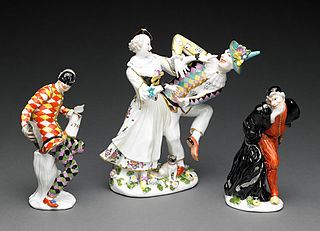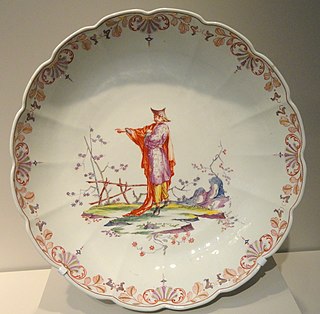
Porcelain is a ceramic material made by heating substances, generally including materials such as kaolinite, in a kiln to temperatures between 1,200 and 1,400 °C. The strength and translucence of porcelain, relative to other types of pottery, arises mainly from vitrification and formation of the mineral mullite within the body at these high temperatures. Though definitions vary, porcelain can be divided into three main categories: hard-paste, soft-paste, and bone china. The category that an object belongs to depends on the composition of the paste used to make the body of the porcelain object and the firing conditions.

Leopoldstadt is the 2nd municipal district of Vienna in Austria. As of 1 January 2016, there are 103,233 inhabitants over 19.27 km2 (7 sq mi). It is situated in the heart of the city and, together with Brigittenau, forms a large island surrounded by the Danube Canal and, to the north, the Danube. It is named after Leopold I, Holy Roman Emperor. Due to its relatively high percentage of Jewish inhabitants before the Holocaust, Leopoldstadt gained the nickname Mazzesinsel. This context was a significant aspect for the district twinning with the New York City borough Brooklyn in 2007.

Goldscheider Porcelain Manufactory and Majolica Factory was an Austrian ceramic manufactory.

Imari ware is a Western term for a brightly-coloured style of Arita ware Japanese export porcelain made in the area of Arita, in the former Hizen Province, northwestern Kyūshū. They were exported to Europe in large quantities, especially between the second half of the 17th century and the first half of the 18th century.

Kakiemon is a style of Japanese porcelain, with overglaze decoration called "enameled" ceramics. It was originally produced at the factories around Arita, in Japan's Hizen province from the Edo period's mid-17th century onwards. The style shares much in common with the Chinese "Famille Verte" style. The quality of its decoration was highly prized in the West and widely imitated by major European porcelain manufacturers during the Rococo period.

Soft-paste porcelain is a type of ceramic material in pottery, usually accepted as a type of porcelain. It is weaker than "true" hard-paste porcelain, and does not require either the high firing temperatures or the special mineral ingredients needed for that. There are many types, using a range of materials. The material originated in the attempts by many European potters to replicate hard-paste Chinese export porcelain, especially in the 18th century, and the best versions match hard-paste in whiteness and translucency, but not in strength. But the look and feel of the material can be highly attractive, and it can take painted decoration very well.

Meissen porcelain or Meissen china was the first European hard-paste porcelain. Early experiments were done in 1708 by Ehrenfried Walther von Tschirnhaus. After his death that October, Johann Friedrich Böttger continued von Tschirnhaus's work and brought this type of porcelain to the market, financed by Augustus the Strong, King of Poland and Elector of Saxony. The production of porcelain in the royal factory at Meissen, near Dresden, started in 1710 and attracted artists and artisans to establish, arguably, the most famous porcelain manufacturer known throughout the world. Its signature logo, the crossed swords, was introduced in 1720 to protect its production; the mark of the swords is reportedly one of the oldest trademarks in existence.

The Manufacture nationale de Sèvres is one of the principal European porcelain factories. It is located in Sèvres, Hauts-de-Seine, France. It is the continuation of Vincennes porcelain, founded in 1740, which moved to Sèvres in 1756. It has been owned by the French crown or government since 1759, and has always maintained the highest standards of quality. Almost immediately, it replaced Meissen porcelain as the standard-setter among European porcelain factories, retaining this position until at least the 19th century.

Palais Augarten is a Baroque palace in the district of Leopoldstadt, Vienna, Austria. Constructed in the late seventeenth century by Johann Bernhard Fischer von Erlach on the site of a hunting château and gardens, the palace and gardens were expanded in the nineteenth century under Emperor Franz Joseph I of Austria. Despite extensive damage suffered during World War II, the palace has been maintained almost in its original appearance, and many of the original furnishings can still be found there. Today, Palais Augarten is the home and rehearsal space of the Vienna Boys' Choir, who also have their own school there. The palace is located in the 130-acre Augarten park, which is the oldest Baroque garden in Vienna.

The Imperial Porcelain Factory, also known as the Imperial Porcelain Manufactory, is a producer of hand-painted ceramics in Saint Petersburg, Russia. It was established by Dmitry Ivanovich Vinogradov in 1744 and was supported by the Russian tsars since Empress Elizabeth. Many still refer to the factory by its well-known former name, the Lomonosov Porcelain Factory.

The Doccia porcelain manufactory, at Doccia, a frazione of Sesto Fiorentino, near Florence, was in theory founded in 1735 by marchese Carlo Ginori near his villa, though it does not appear to have produced wares for sale until 1746. It has remained the most important Italian porcelain factory ever since.

The Augarten is a public park of 52.2 hectares situated in the Leopoldstadt, the second district of Vienna, Austria. It contains the city's oldest Baroque park.

The Herend Porcelain Manufactory is a Hungarian manufacturing company, specializing in luxury hand painted and gilded porcelain. Founded in 1826, it is based in the town of Herend near the city of Veszprém.

The Royal Porcelain Factory in Berlin, also known as the Royal Porcelain Manufactory Berlin and whose products are generally called Berlin porcelain, was founded in 1763 by King Frederick II of Prussia. Its actual origins, however, lie in three private enterprises which, under crown patronage, were trying to establish the production of "white gold" in Berlin from the mid-18th century onwards.

The Londonderry Vase is a hard-paste porcelain vase, standing at 54 inches tall. It is decorated with polychrome enamels, gilding and gilt bronze mounts. It bears the Sèvres mark, two intersecting Ls with a letter in the center denoting its creation year (1813-1815) and a crown over the L's to mark it as hard-paste. The vase was commissioned by Napoleon around 1805 to be created by the Sèvres Manufactory. The vase is currently on display at the Art Institute of Chicago.

Vienna porcelain is the product of the Vienna Porcelain Manufactory, a porcelain manufacturer in Alsergrund in Vienna, Austria. It was founded in 1718 and continued until 1864.

Hollóháza porcelain is produced by the Porcelain Manufactory of Hollóháza, Hungary. The manufactory was founded in 1777, originally as glassworks. It is one of the oldest remaining, now state-owned porcelain manufactury in Hungary.

Ludwigsburg porcelain is porcelain made at the Ludwigsburg Porcelain Manufactory founded by Charles Eugene, Duke of Württemberg, on 5 April 1758 by decree as the Herzoglich-ächte Porcelaine-Fabrique. It operated from the grounds of the Baroque Ludwigsburg Palace. After a first two decades that were artistically, but not financially, successful, the factory went into a slow decline and was closed in 1824. Much later a series of other companies used the Ludwigsburg name, but the last production was in 2010.

Ena Rottenberg was a Hungarian-Austrian craftswoman, draftswoman, ceramist and member of the artists' community of the Wiener Werkstätte.






















